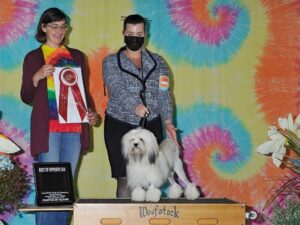
Alexia Rodriguez | Potrero Cane Corsos and Lowchen
Interview with Alexia Rodriguez on Cane Corsos and Lowchen breeding, mentors, and the state of the dog fancy.
Home » Dog Breeds » Cane Corso Dog Breed
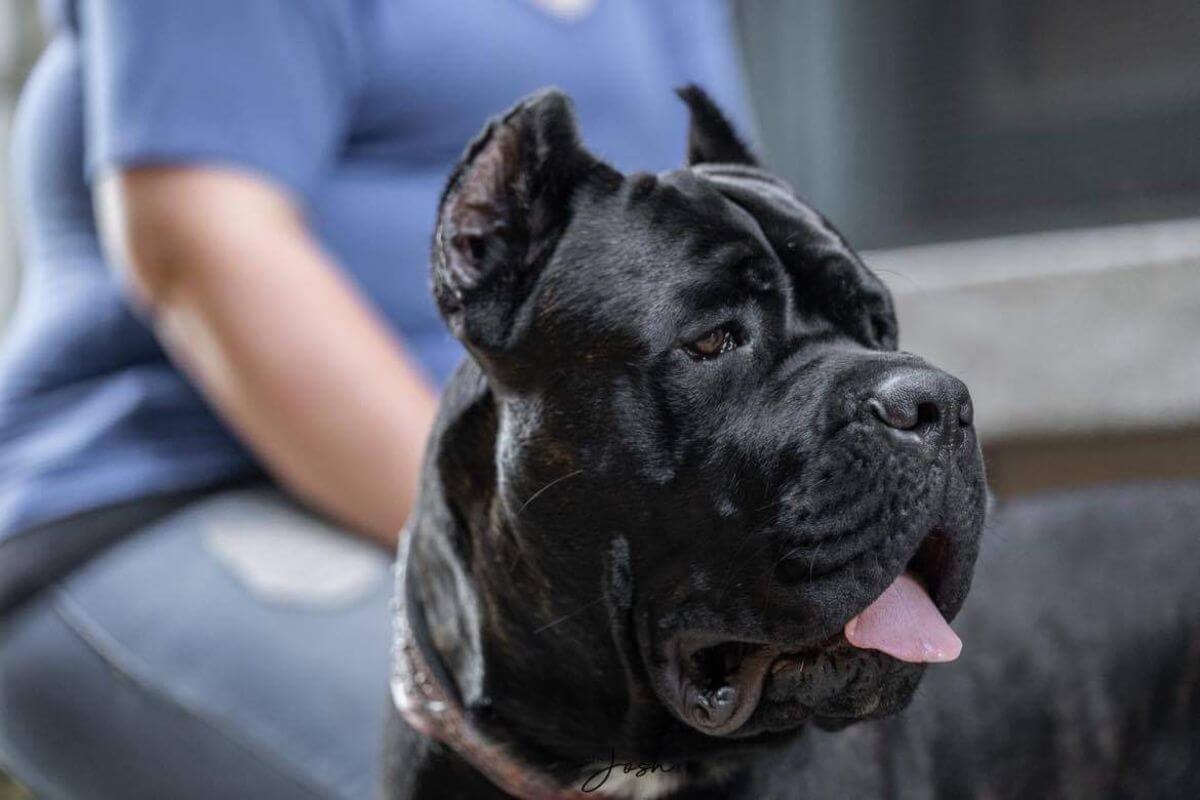
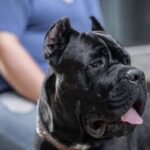

The Cane Corso (plural Cani Corsi) is a majestic and powerful breed that descends from ancient Roman war dogs. With a commanding presence and an impressive physique, this breed exudes both strength and confidence. Originally bred for hunting and guarding, the “Corso” is known for its intelligence, loyalty, and protective instincts. Despite its formidable appearance, these dogs are known to be affectionate with their families, showcasing their softer side within the household.
Working
23.5 – 27.5 Inches
Proportionate to height
9 – 12 Years
| Country of Origin | Italy |
|---|---|
| Bred For | Guarding, Protection, Large Game Hunting |
| Known For | Alert Expression, Impressive Presence, Protectiveness |
| Popularity | Moderate |
| Temperament | Intelligent, Majestic, Noble, Powerful |
| Activities | Farm Dog, Guard Dog, Conformation Shows, Dog Sports |
The history of the Cane Corso is deeply intertwined with their Italian heritage, tracing back to the Molossers of ancient Rome. As descendants of Roman dogs of war, Cani Corsi were originally bred for battle, providing protection, and hunting large game animals such as wild boar. The breed’s name is derived from the Latin “cohors,” meaning guardian or protector, which aptly describes the dog’s primary roles throughout history.
With the fall of the Roman Empire, the role of the Corso evolved. The dogs were adapted to life in rural Italy where they were used as farm dogs. Their tasks included herding cattle, guarding property, and protecting livestock from predators. The dogs’ versatility and intelligence made them indispensable to Italian farmers and landowners.
Following World War II, the breed faced a decline in numbers and was on the brink of extinction due to industrialization and the decline of an agrarian lifestyle. Dedicated enthusiasts in Italy began a revival program in the 1970s to save the breed. They gathered the few remaining dogs and started a careful breeding program to preserve the breed’s lineage and its unique characteristics.
The Cane Corso was officially recognized by the American Kennel Club (AKC) in 2010, marking a significant milestone in the breed’s history. The breed’s recognition in the United States and by major registries around the world acknowledge its many fine qualities as well as its historical significance.
Today, the “Italian Mastiff” is cherished not only in Italy but worldwide, revered for its loyalty, protective nature, and noble bearing. While the Corsi retain their protective instincts, these noble dogs are increasingly seen as family companions, known for their affectionate and gentle interactions with their loved ones.
The Cane Corso’s journey from Roman battlefields to modern homesteads is a testament to the breed’s adaptability and its enduring spirit, securing a place in the annals of Molosser history.
An adult male Cane Corso typically stands between 25 and 27.5 inches tall at the shoulder, while mature females are slightly smaller, measuring from 23.5 to 26 inches tall.
In terms of weight, both males and females possess a muscular and athletic build, weighing between 90 and 110 pounds.
The Cane Corso is a muscular, well-balanced, and large-boned dog, known for its rectangular proportion. The breed’s build is a striking blend of strength and agility, reflective of the historical roles that demanded power and endurance. The length of the breed, measured from the point of the shoulder to the point of the buttock, is approximately 10 percent greater than its height as measured from the highest point of the shoulder to the ground.
The sturdy frame of the Cane Corso, combined with its well-developed muscles, portrays a robust and formidable presence. Yet, despite the breed’s physical strength, Corsi possess a level of grace and fluidity in their movements that is indicative of both ease and elegance.
Texture: The coat of the Cane Corso is characteristically short, yet it distinguishes itself with a subtly, rough texture. This unique texture not only contributes to the breed’s rugged and robust appearance, it also provides a practical layer of protection in various weather conditions. Beneath the outer coat lies a light undercoat that becomes more dense in response to colder climates, thus offering increased insulation. This adaptability of coat density allows the Corso to remain comfortable and protected in a variety of environments, highlighting the breed’s resilience and versatility.
| Standard Color | |
|---|---|
| Black | ee |
| Gray | ee |
| Fawn | ee |
| Black Brindle | ee |
| Gray Brindle | ee |
| Red | ee |
| Chestnut Brindle | ee |
A Note About Color: The Cane Corso’s coat color may be either black, red, shades of gray, or shades of fawn. Solid fawn or red-colored dogs have a black or gray mask, which does not extend beyond the eyes. Brindling of the coat is acceptable, as is white on the chin, throat, chest, backs of the pasterns, and on the toes. Tan pattern markings are unacceptable in the breed as are colors such as chocolate, liver, and straw (light cream without a mask).
| Standard Marking | |
|---|---|
| Black Mask | ee |
| Gray Mask | ee |
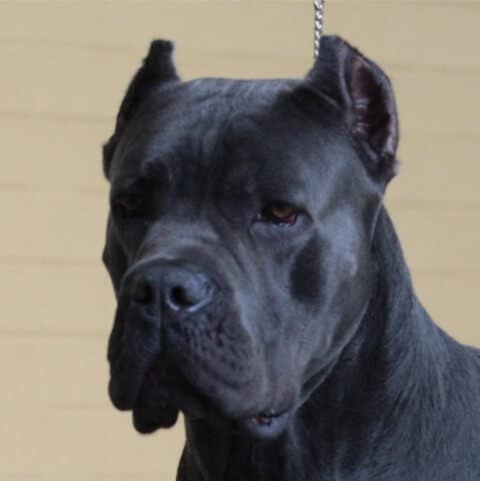
The tail of the Cane Corso is set high and is an extension of the topline. When the dog is alert or in motion, the tail is carried higher but never curls over the back. Traditionally, the tail has been docked, but this practice varies based on legal restrictions and personal preferences. When undocked, the tail’s natural length complements the dog’s balanced proportions and adds to the fluidity of its movement.
The Cane Corso, known for its strength, loyalty, and protective instincts, is a distinguished choice for discerning dog enthusiasts. However, owning a Corso, as with any dog, entails specific responsibilities and considerations crucial for the well-being of both the dog and its owner.
The Cane Corso is typically a robust and sturdy breed, reflecting its heritage as a guardian and hunter. However, like all breeds and mixed breeds, Corsi can be susceptible to certain health conditions. Prospective owners should be aware of these potential issues and engage with reputable breeders and veterinarians to maintain their dog’s health throughout its life.
Lifespan: The average lifespan of a Cane Corso ranges from 9 to 12 years. With proper care, regular veterinary check-ups, and a balanced diet, many Corsi can enjoy a full and healthy life.
Despite the breed’s overall hardiness, Cani Corsi may be prone to some health concerns, including:
Regular veterinary check-ups are vital for the early detection of these and other potential health issues in the Cane Corso. General wellness exams, along with specific screenings for hips, elbows, and heart health, are recommended to support the ongoing health and well-being of the dog.
Owning a Cane Corso means understanding and catering to its unique personality traits and temperamental needs. Renowned for its loyalty and protective nature, the breed is deeply devoted to its family, often forming strong bonds with its owners. The Corso, while reserved and cautious around strangers, displays a remarkable level of affection and gentleness within the family circle.
Cani Corsi are generally suitable for experienced dog owners due to their strong personalities and great size. These dogs respond well to confident and consistent leadership, making them more manageable for those who are familiar with handling large, powerful breeds. Early and ongoing socialization is crucial for this breed so that the dogs become well-adjusted and comfortable in various situations.
Their sensitivity to their owners’ emotions makes the Corso an intuitive companion, often responding to the mood and atmosphere of the home. While these dogs can adapt to being alone for reasonable periods, like all dogs they prefer the company of their family and can become anxious if left isolated for too long.
Cani Corsi typically get along with other pets, especially if raised with them from a young age. However, due to their protective instincts, they may be wary of unfamiliar animals. Introducing new pets should be done cautiously and under controlled conditions.
When it comes to children, the Corso can be a gentle and protective companion. However, interactions with young kids should always be supervised due to the breed’s size and strength. Teaching children how to interact safely and respectfully with the dog is equally important.
Friendly towards familiar faces but reserved with strangers, the Cane Corso is not overtly aggressive without cause. The breed tends to assess situations and responds based on a perceived threat level, showing its protective nature only when necessary.
Feeding and nutrition are key components in maintaining the health and vitality of a Cane Corso. Given their large size and active nature, Cani Corsi require a diet that adequately supports their energy needs and promotes overall well-being.
For Cane Corso puppies, a nutrient-rich diet formulated for large breeds is essential. Puppies have different nutritional requirements to support their rapid growth and development. It’s important to feed them a balanced diet that promotes healthy bone and muscle development, typically divided into multiple meals throughout the day to support their metabolism and growth.
As Cani Corsi transition into adulthood, their dietary needs change. Adult Cani Corsi usually do well on two meals per day. The amount of food, typically measured in cups, varies based on the individual dog’s size, age, and activity level. An average adult Cane Corso may require around 4 to 5 cups of dry dog food per day, but this can vary. It’s crucial to monitor their weight and adjust food portions accordingly to prevent obesity, which can be a health concern for large breeds.
Proper hydration is also essential. Fresh water should be available at all times to make sure that the Cane Corso stays well-hydrated, especially after exercise or in hot weather.
Choosing high-quality dog food with appropriate ingredients is vital. Look for foods that list real meat as the first ingredient and avoid those with excessive fillers or artificial additives. Given that some Cani Corsi can have sensitivities to certain foods, it’s important to be observant for signs of allergies or digestive issues and consult with a veterinarian for dietary advice.
Feeding a Cane Corso a balanced diet that meets their specific nutritional needs is essential for their health and longevity. Regular check-ins with a veterinarian can help ensure that your Cane Corso is receiving the right amount of nutrients for their age, size, and activity level.
Training a Cane Corso is an essential aspect of their care and should be approached with consistency, patience, and understanding of the breed’s characteristics. Known for their intelligence and eagerness to please, Cani Corsi can be highly trainable with the right approach.
Due to their large size and protective nature, early socialization and obedience training are crucial for Cani Corsi. Exposing them to a variety of people, environments, and situations from a young age helps develop a well-rounded and confident dog. This breed responds best to positive reinforcement techniques, such as treats, praise, and affection, which encourage and reward good behavior.
Cani Corsi are recognized for their protective instincts, often appearing as a natural wariness towards strangers. This characteristic contributes to their effectiveness as guard dogs and highlights the necessity of training. Such training aids in helping them differentiate between normal and threatening scenarios. With appropriate training, their protective behavior is more manageable, promoting calmness and control.
While they are not known for excessive barking, Cani Corsi may bark to alert their owners of something unusual or if they perceive a threat. Training them to understand commands such as ‘quiet’ or ‘enough’ is important to manage their vocalizations effectively.
Cani Corsi’s intelligence and physical prowess make them well-suited for advanced training and dog sports. Activities like obedience trials, agility, and tracking can provide mental stimulation and physical exercise, which are important for this active breed.
Despite their size and strength, Cani Corsi can be sensitive and respond poorly to harsh training methods. A firm, yet gentle approach is key, building a relationship based on mutual respect and trust. Consistency in training routines and expectations is essential in developing a well-behaved and happy Cane Corso.
Regular exercise is crucial for the well-being of a Cane Corso, given their size and energy levels. This breed thrives on physical activity and mental stimulation, which are essential for maintaining their health and preventing behavioral issues.
| Energy Level | Moderate to High |
|---|---|
| Exercise Requirements | 30 Minutes/Day (Minimum), Daily Walks, Vigorous Running, Regular Exercise, Playing with Another Dog, Mental Stimulation |
Cani Corsi require a substantial amount of exercise to keep them fit and content. This should include daily walks, play sessions, and opportunities for them to run and explore in a safe, enclosed area. Their exercise regimen should be vigorous enough to satisfy their high energy levels but also tailored to their size and build to avoid overexertion.
Despite their large size, Cani Corsi possess a notable degree of agility and stamina. Engaging them in activities that challenge both their mind and body, such as obedience training, agility courses, and interactive games, can be highly beneficial. These activities not only provide physical exercise but also help to strengthen the bond between the dog and its owner.
It’s important to remember that, as a large and muscular breed, the exercise needs of the Cane Corso might be more demanding than those of smaller breeds. However, their exercise should be appropriately scaled during their puppyhood to avoid putting undue stress on their developing joints and bones.
In addition to physical activities, mental stimulation is equally important for this intelligent breed. Puzzle toys, scent work, and training challenges can keep their minds active and engaged, preventing boredom and potential destructive behavior.
Grooming is an essential aspect of caring for a Cane Corso, contributing not only to their appearance but also to their overall health. Despite having a short coat, this breed requires regular grooming to maintain its condition and to support good skin health.
| Coat Type | Double, Short, Stiff, Shiny, Adherent, Dense |
|---|---|
| Grooming Requirements | Weekly Brushing, Occasional Bathing, Routine Ear Cleaning, Periodic Nail Trimming, Regular Tooth Brushing |
The coat of a Cane Corso is short and dense, requiring regular brushing to remove loose fur and reduce shedding. A weekly brushing session with a suitable bristle brush or a hound glove can help keep their coat shiny and healthy. This routine also helps in distributing natural skin oils throughout their coat, enhancing its sheen and vitality.
Bathing a Cane Corso should be done as needed, typically every few months, unless they get particularly dirty or start to develop an odor. It’s important to use a dog-specific shampoo that is gentle on their skin to avoid drying out their coat. Regular baths help to keep their skin clean and reduce the chance of skin infections, which can be common in larger breeds.
In addition to coat care, other grooming essentials include nail trimming and ear cleaning. Their nails should be trimmed regularly to prevent discomfort and potential problems with walking. Their ears should also be checked and cleaned regularly to prevent the buildup of wax and debris, which can lead to infections, especially considering their floppy nature.
Dental hygiene is another important aspect of grooming for the Cane Corso. Regular teeth brushing or the use of dental chews can help prevent dental issues, which are common in large breeds.
Living with a Cane Corso is a unique and rewarding experience that entails providing an environment and lifestyle suitable for their size, energy, and protective nature. Cani Corsi, with their large stature, require ample space for movement and exercise, making a home with a spacious yard ideal. However, they can adapt to various living conditions, such as larger apartments, as long as their exercise needs are met. Providing a secure environment is crucial due to their natural instinct to guard.
Cani Corsi have a short coat that offers some resistance to cold, but in extreme weather, additional measures like a warm coat may be necessary. In contrast, during warmer temperatures, it’s important to provide cool, shaded areas and ample water to prevent overheating.
These dogs are known for their deep loyalty and affection towards their family, thriving on regular interaction and involvement in family activities. While generally good with children, supervision is advised during interactions due to the breed’s size and strength.
Regular exercise is not just a physical requirement for a Cane Corso but also a mental one. Activities that challenge them physically and mentally are beneficial for their overall well-being. Alongside physical activities, mental stimulation is vital, which can be provided through training exercises and interactive play.
Considering their protective nature, socialization and consistent training from a young age are essential. This helps in developing a well-mannered and confident dog, capable of distinguishing between normal and threatening situations.
Bringing a Cane Corso puppy into the home is a journey filled with excitement and challenges. These puppies, known for their robustness and spirited nature, quickly become integral members of the family. However, raising a Corso pup correctly requires commitment and understanding of the breed’s specific needs during the puppy’s formative months.
Caring for a Cane Corso puppy goes beyond providing basic necessities like food and shelter; it involves nurturing the pup’s overall development. From a dietary perspective, the Corso puppy needs food that supports rapid growth, one that is particularly formulated for large breeds. It is essential to offer a balanced nutrition that fosters healthy bone and muscle development, usually divided into multiple meals to sustain a growing puppy’s high energy levels.
Training and socialization should begin early for the Cane Corso puppy. Introducing the pup to a variety of experiences, environments, and people helps in molding its temperament and behavior. Housetraining, basic obedience, and social manners are fundamental aspects of this early education. Positive reinforcement techniques work well during training sessions, encouraging good behavior with treats and praise.
Regular veterinary check-ups are crucial to monitor the puppy’s growth and health, keeping up with vaccinations and preventive care. Puppyhood is also the time to establish a grooming routine, getting the growing pup accustomed to being handled, brushed, and bathed, which is important for its long-term care.
Exercise for the Cane Corso pup should be age-appropriate. While the Corso puppy is typically energetic and playful, its exercise should not be too strenuous, to avoid stress on the developing joints. Short, gentle walks and play sessions are suitable for the pup’s physical condition at this stage.
Providing a safe and loving environment is key to the Corso puppy’s well-being. A secure space where it can explore and rest is essential, along with consistent interaction and affection. This early stage of life lays the foundation for the pup’s future temperament and health as an adult.
Raising a Cane Corso puppy is a significant commitment that involves catering to the puppy’s nutritional, health, training, and emotional needs. By providing a supportive and caring environment, the Corso puppy will grow into a well-rounded, healthy, and loyal companion.
Cani Corsi are adept at a variety of activities that provide these big dogs with the necessary physical exercise and mental stimulation they require. Some of the dog sports in which a Corso can excel include:
Engaging a Cane Corso in these activities can not only keep the dog physically fit, it can also encourage it to be mentally sharp. Choosing the right activities based on a dog’s individual personality and abilities will guarantee a rewarding experience for both the dog and its handler.
The Cane Corso is recognized by the world’s leading registries and kennel organizations, which categorize the breed into a specific Group based on its unique characteristics. This breed is recognized worldwide under the following Group designations:
| Organization | Group Designation |
|---|---|
| AKC (American Kennel Club) | Working |
| UKC (United Kennel Club) | Guardian |
| CKC (Canadian Kennel Club) | Working |
| ANKC (Australian National Kennel Council) | Utility |
| RKC (The Royal Kennel Club) | Not Recognized |
| FCI (Fédération Cynologique Internationale) | Group 2: Pinscher and Schnauzer Molossoid Breeds – Swiss Mountain and Cattle Dogs; Section 2.1.: Molossian, Mastiff Type |
The ideal Cane Corso is described by a Breed Standard that is approved by each of the world’s leading registries and kennel organizations. The Breed Standards for this breed may be found in the following links:
| Organization | Breed Standard |
|---|---|
| American Kennel Club | AKC Cane Corso Breed Standard |
| United Kennel Club | UKC Cane Corso Breed Standard |
| Canadian Kennel Club | CKC Cane Corso Breed Standard |
| Australian National Kennel Council | ANKC Cane Corso Breed Standard |
| The Royal Kennel Club | Not Recognized |
| Fédération Cynologique Internationale | FCI Cane Corso Breed Standard |
The Cane Corso has garnered a dedicated following, and its presence is strongly felt in several canine organizations around the world. These clubs serve as a crucial resource, offering breed-specific information, support, and events that cater to both experienced owners and those who are new to the breed.
The Cane Corso Association of America (CCAA) is the official national club and AKC parent club for the Cane Corso in the United States. The CCAA is committed to enhancing the quality and welfare of the breed, providing educational resources and health information, as well as organizing breed-focused activities.
The Canadian Cane Corso Association, founded in February 2010, is the national club for Cani Corsi in Canada. It operates under the rules of the Canadian Kennel Club (CKC) and focuses on the preservation and protection of the breed, offering extensive information and coordinating with regional clubs across the country.
Joining these clubs offers a rewarding experience for Cane Corso enthusiasts, fostering a community where individuals can share, learn, and celebrate all aspects of this majestic breed.
The Cane Corso may occasionally find itself in need of a new home due to a variety of circumstances, such as owner health issues, financial challenges, or behavioral difficulties. Thankfully, dedicated breed rescue organizations around the world are committed to the care, rehabilitation, and rehoming of any Corso in need. These volunteer groups play a vital role in providing support and care for these dogs and their caretakers.
In the United States, one prominent organization is Cane Corso Rescue, Inc. This national rescue group is dedicated to placing Cani Corsi into the best possible forever homes and educating the public about the breed. Since its inception in 2005, the group has rescued and adopted over 1,500 Corsi. Another notable U.S. based rescue is Must Love Corsos Rescue, a community-based non-profit that is dedicated to saving neglected or abandoned Corsi.
In Canada, the Canadian Cane Corso Association works in collaboration with Cane Corso Rescue, Inc. to place dogs in the United States and Canada. This group, based in Western Canada, is actively involved in the rescue and rehoming of Corsi, ensuring the welfare of each and every dog that comes into the organization’s care.
In the United Kingdom, the Cane Corso UK & Molosser Rescue is committed to rescuing Cani Corsi and other Molosser breeds. This small but dedicated rescue group focuses on rehoming dogs in need and rehabilitating them to become well-adjusted, happy dogs. The group operates in Bedfordshire, Milton Keynes, County Durham, and utilizes foster homes across the country. Additionally, the Cane Corso Appreciation Society UK supports Large Breed Dog Rescue in Kent, a registered charity that also helps with rescuing and rehoming Corsi.
In addition to these dedicated Cane Corso rescue groups, local shelters and broader animal rescue organizations can also play a vital role in providing care and rehoming opportunities for individuals of the breed. These organizations provide a crucial service by offering dogs a second chance at finding a loving home. This include any Corso that might enter their system. Supporting these rescues groups through adoption, volunteering, or donations could make a positive impact on the life of a Corso that has found itself in need of assistance.
An adult male Cane Corso typically stands between 25 and 27.5 inches tall at the shoulder, while females are slightly smaller, measuring 23.5 to 26 inches in height. In terms of weight, both males and females possess a frame that is proportionate to their height, contributing to a well-balanced and powerful physique.
Yes, the Cane Corso does shed, but the amount is moderate. Regular grooming is essential to control shedding and to keep the coat healthy. The use of a proper brush for short-coated breeds can effectively remove loose hair and reduce shedding in the home.
The average life expectancy of a Cane Corso is around 9 to 12 years. However, with proper care, nutrition, and regular veterinary check-ups, some Corsi can live longer. Factors such as genetics, diet, exercise, and healthcare all play a role in determining lifespan.
Cane Corso is pronounced as “Kah-neh Kor-so.” The name comes from Italian, where “cane” means dog and “corso” refers to guard or protector, reflecting the breed’s guarding and protective traits.
Cani Corsi can be good with kids, especially if they are raised with them or properly socialized around them from a young age. Due to their size and strength, supervision is recommended when they interact with young children. It is important to teach both the dog and the kids how to interact safely and respectfully with each other.
Cani Corsi are not inherently aggressive, but they are a strong-willed breed with protective instincts. Proper training, socialization, and responsible ownership are crucial for preventing any aggressive behaviors. With the right upbringing, they can be calm, controlled, and loyal companions.
Cani Corsi can drool, especially after drinking water or when they are anticipating food. While they are not the most excessive droolers among large dog breeds, potential owners should be prepared for some drooling, particularly in response to stimuli like the smell of food.
Cani Corsi typically stop growing in height by around 18 months, but they may continue to fill out and gain muscle until they are about two years old. To ensure healthy development, it is important during their growth phase to provide adequate nutrition and avoid excessive exercise.
Cani Corsi can make excellent family dogs for owners who understand and respect their characteristics. They are known for their loyalty and protective nature, often forming strong bonds with family members. However, due to their size and protective instincts, proper training, socialization, and supervision are essential, especially around children and other pets.
Cani Corsi were originally bred for a variety of purposes, including guarding property, hunting big game, and herding cattle. Their history as Roman dogs of war has equipped them with a protective and robust nature, making them versatile and formidable working dogs.
Cani Corsi can get along with other dogs, especially if they are socialized from a young age. However, due to their strong protective instincts, interactions with unfamiliar dogs should always be supervised. Early socialization is key to developing their social skills.
No dog is truly hypoallergenic, including the Cane Corso. While the breed has a short coat and is only a moderate shedder, these dogs still produce dander and saliva, which are common allergens. People with allergies should spend time with the breed before deciding to own one.
The Cane Corso is known to have a strong bite, with a bite force that is among the highest among all dog breeds. The exact measurement, however, can vary. The breed’s strong bite is a remnant of its history as a hunter and guard dog.
Cani Corsi do not inherently turn on their owners. Incidents where dogs become aggressive often stem from improper training, abuse, neglect, or lack of socialization. An underlying health issue can also be responsible. Ownership of this breed is a responsibility that necessitates proper training and care, crucial tools for preventing aggressive behavior in the dog.
Cani Corsi can be good with cats, particularly if they are raised with them from a young age. However, due to the breed’s hunting instincts, each dog’s temperament and reaction to cats can vary. Supervised introductions and socialization are important.
The average litter size for a Cane Corso ranges from four to eight puppies. However, this can vary based on the individual dog’s health, age, and genetics. Larger litters are not uncommon in the breed.

Interview with Alexia Rodriguez on Cane Corsos and Lowchen breeding, mentors, and the state of the dog fancy.
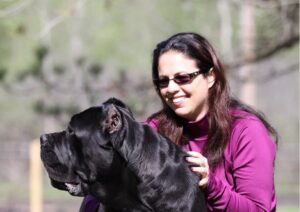
Ayalla Ruvio is the breeder behind the Black Pearl Cane Corso. Read about the kennel’s beginnings, champion dogs, Cane Corso puppies and more!

Shauna DeMoss is the breeder behind CastleGuard Cane Corsos. Read about the kennel’s beginnings, champion dogs, Cane Corso puppies and more!
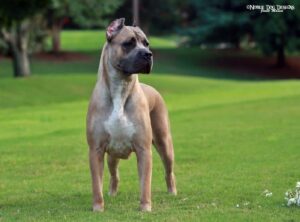
Lack of consistency continues to be a major problem in the Cane Corso. Breed Education department of the CCAA points that may help judges.
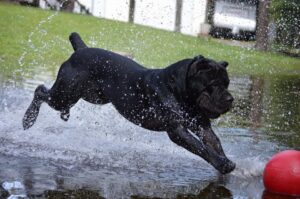
It doesn’t take much observation to see a significant size variation in the Cane Corso. It’s all over the place. From ringside to the
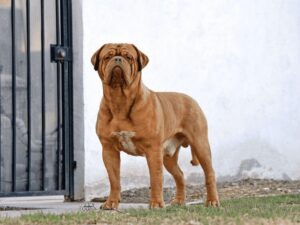
In this installment of the series, the remaining six Molossoid breeds of Mastiff type (Boerboel, Bullmastiff, Cane Corso, Dogue de Bordeaux

Interview with Alexia Rodriguez on Cane Corsos and Lowchen breeding, mentors, and the state of the dog fancy.

Ayalla Ruvio is the breeder behind the Black Pearl Cane Corso. Read about the kennel’s beginnings, champion dogs, Cane Corso puppies and more!

Shauna DeMoss is the breeder behind CastleGuard Cane Corsos. Read about the kennel’s beginnings, champion dogs, Cane Corso puppies and more!

Lack of consistency continues to be a major problem in the Cane Corso. Breed Education department of the CCAA points that may help judges.

It doesn’t take much observation to see a significant size variation in the Cane Corso. It’s all over the place. From ringside to the

In this installment of the series, the remaining six Molossoid breeds of Mastiff type (Boerboel, Bullmastiff, Cane Corso, Dogue de Bordeaux
The best way to ensure a long and happy relationship with a purebred dog is to purchase one from a responsible breeder. Not sure where to begin?
Contact the National Parent Club’s Breeder Referral Program, which is listed on the AKC Breeder Referral Contacts page.
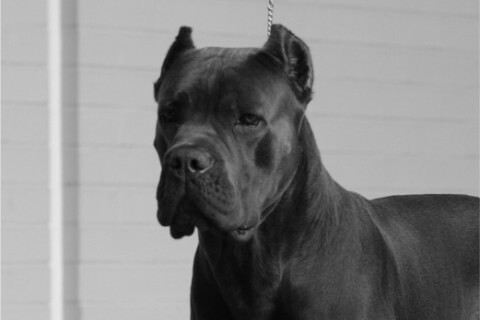

"*" indicates required fields
Showsight Magazine–the world’s most influential purebred dog publication since 1992. Each issue reaches a global audience dedicated to preserving the history and health of purpose bred dogs. Filled with award-winning editorial focused on news and insights from the dog show community, top breeders, handlers, AKC Judges, and more!